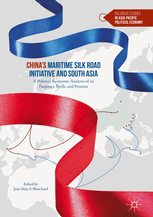
Edited by Jean-Marc F. BlaJean-Marcublished by Palgrave Macmillan – 2017)
The book “China’s Maritime Silk Road Initiative and South Asia: A Political Economic Analysis of its Purposes, Perils and Promises” is edited by Jean Marc F. Blanchard and published by Palgrave Macmillan. The book is a coalescence of eight chapters which is the result of an academic conference titled “The Political Economy of China’s Maritime Silk Road Initiative and South Asia” held by Mr. & Mrs S. H. Wong Centre for the Study of Multinational Corporations and the East China Normal University School of Advanced International Area Studies in 2015. The focus is therefore restricted to the Maritime Silk Road Initiative by closely examining the political-economic aspect.
The first chapter is an introductory chapter titled ‘China’s Twenty-First Century Maritime Silk Road Initiative and South Asia: Political and Economic Contours, Challenges and Conundrums’ by Jean Blanchard. He points out the limitations in the existing literature in the study of ‘One Belt One Road’ and addresses the shortcomings that make the papers incorporated in the book relevant and significant. Blanchard also puts forth how there are ‘theoretical rationales for studying MSRI’ and affirms the interlinkage between economics and politics along with the importance of non-state actors, private companies, corporations and MSRI non participants in South Asia. The chapter begins by providing information on MSRI along with explaining the features, economic and political objectives and associated challenges that China will face in the realisation of the project. A brief summary of the chapters about the future of MSRI and potential implications are also discussed.
The second chapter by John W. Garver titled ‘China’s Rise and the Eurasian Transportation Revolution’ gives a historic analysis about the transportation technologies and as to how it shapes the interaction between East Asia and South Asia. The significance of geography and the application of technologies is discussed by providing historical context. The author explains the railway and highways as the components of the transportation revolution which enhanced Chinese national power and influence. He further discusses how this revolution changed the geopolitical role of Tibet along with the significance of the Pakistan and Myanmar Corridor for Chinese transports. He opines about a convergence of PRC and US interests that could create uncertainty for India while addressing the infrastructure programs of China in Eurasia.
The control of the Indian Ocean is a strategic issue where China’s MSRI would alter the ocean’s naval balance and dynamics of the region. The chapter by David Brewster titled ‘The MSRI and the Evolving Naval Balance in the Indian Ocean’ provides an understanding of the geography of the Indian Ocean Region leading to its strategic significance and the naval balance in the region. The growing Chinese interests are assessed by giving the Chinese narratives to projects like String of Pearls and Silk Route along with the strategic impacts of such projects. With plans for overland pathways by China in IOR, Brewster also states that the security interactions between Pacific and Indian Oceans will increase through the concept of Indo Pacific and that China may become the resident power in the Indian Ocean rather than being an extra-regional power.
The interests of China and its vision is now at the stage of implementation. Especially for MSRI, South Asia is crucial for China to ensure regional security and stability. In chapter four titled ‘China’s Strategy Towards South Asia in the context of the Maritime Silk Road Initiative’ authored by Xinmin Sui, discusses the Chinese strategy in South Asia within MSRI, the opportunities and challenges in the region. The paper puts forth the objectives of MSRI and its implications in South Asia and examines the hindrances to the implementation and the economic benefits delivered by the project. He views that the world is all about economics and terms it as ‘geo-polionomics’. Further, the author also stresses the need for China to focus on an integrated and balanced policy in South Asia by considering India and Pakistan and argues that the Chinese strategy is not to contain India but is focused on securing the resources and economic interests.
The China-Pakistan nexus is another area of concern from an Indian perspective. The paper by Jabin T Jacob titled ‘The China–Pakistan Economic Corridor and the China–India–Pakistan Triangle’, provides an understanding of the bilateral relation and military ties between China and Pakistan which continues to be important. The author discusses CPEC and the implication of the internal political dynamics of Pakistan on the project. He states how China contributes to Pakistan’s energy sector and economy and further gives an understanding of CPEC from an Indian point of view.
The island state of Sri Lanka is another similar country to Pakistan which have a major Chinese influence. ‘Sri Lanka, the Maritime Silk Road, and Sino-Indian Relations’ by David J. Karl explores the triangular relationship between China, Sri Lanka and India. He also focuses on the tussle between the powers to gain influence in Sri Lanka and examines the possibility of cooperation in the future by looking at the economic engagements. However, he stresses the part that India needs to raise its capacity to contribute to regional development from its experience in Sri Lanka.
The paper titled ‘The Maritime Silk Road and China-Maldives Relations authored by Srikanth Kondapalli provides an overview of the MSR and Chinese views on the Indian Ocean region. He examines the bilateral relation of China with the Maldives and discusses the mutual benefits in political and economic aspects. Though, the author opines that the defence cooperation may pose a challenge to India and the US as Maldives has a strategic location in the IOR.
The final chapter in the book titled ‘The MSRI, China and India: Economic Perspectives and Political Impressions’ is authored by Amitendu Palit. The focus is on the MSRI and regional connectivity where the author discusses the economic rationale, variations in intraregional trade, Indian business and strategic perspectives. The regional cooperation, trade rules, land transit challenges associated with the project is also examined. He also provides a deep understanding of the China-India bilateral relations from an economic aspect through stating the Chinese investment in India. A comparison of the domestic maritime capacities, land connectivity and domestic infrastructure are also examined. The author points out that although India has a unique strategic location in the MSRI project, it is important for India to increase its maritime facilities and logistic capabilities through which India can utilise the economic benefits of MSRI. The need for China to become transparent in its initiatives in South Asia and Southeast Asia is also mentioned for better regional associations and commitment.
The Belt and Road Initiative is a contemporary relevant topic and with China pursuing cordial relationships with diverse countries in South Asia through political and economic means, this book is timely and significant. The emphasis on MSRI and its analysis by considering different countries adds more value to the book. The use of specific data and references proves to be resourceful and the book will be critical to policymakers, academic enthusiasts and students interested in International Relations, Chinese foreign policies and South Asia.













